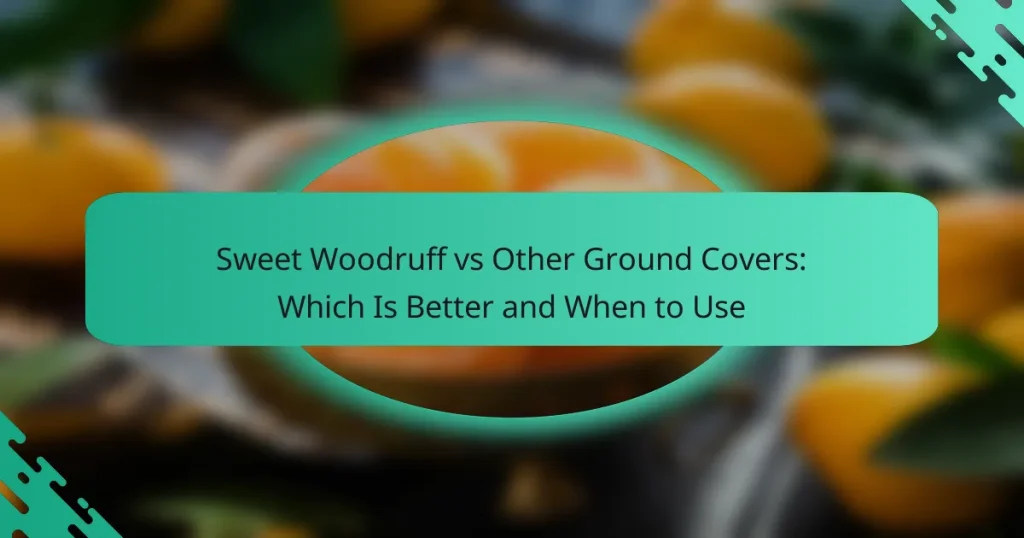When considering ground covers for shady areas, Sweet Woodruff stands out for its hardiness and ability to thrive in moist, well-drained soil. While it enhances the beauty of woodland gardens and suppresses weeds, other options like Creeping Thyme offer different benefits, such as drought resistance and vibrant blooms. Understanding the unique characteristics of each ground cover will help you choose the best option for your landscape needs.

What are the best ground covers for shady areas in Los Angeles?
In Los Angeles, the best ground covers for shady areas include Sweet Woodruff and several other options that thrive in low-light conditions. These plants not only enhance the aesthetic appeal but also help with soil erosion and weed suppression.
Sweet Woodruff advantages
Sweet Woodruff is an excellent choice for shady areas due to its ability to thrive in low light and its fragrant foliage. This perennial ground cover can create a lush green carpet, especially in cooler months, and produces small white flowers in spring.
Additionally, Sweet Woodruff is relatively low-maintenance, requiring minimal watering once established. Its dense growth habit helps suppress weeds effectively, making it a practical option for gardeners looking to minimize upkeep.
Other ground covers options
Other suitable ground covers for shady areas in Los Angeles include Creeping Thyme, Ajuga, and Vinca Minor. Creeping Thyme offers a fragrant option that can tolerate some foot traffic, while Ajuga features vibrant foliage and blue flowers.
Vinca Minor, or Periwinkle, is another popular choice, known for its rapid growth and ability to spread quickly. Each of these alternatives has unique characteristics that can complement various garden designs.
Comparison of growth conditions
Sweet Woodruff prefers moist, well-drained soil and can tolerate partial to full shade, making it ideal for under trees or in shaded garden beds. In contrast, Creeping Thyme thrives in well-drained soil with full sun exposure, while Ajuga and Vinca Minor can adapt to both sun and shade.
When selecting a ground cover, consider the specific light and moisture conditions of your garden. This will ensure that the chosen plant will flourish and provide the desired coverage.
Maintenance requirements
Sweet Woodruff requires minimal maintenance, needing occasional watering during dry spells and light pruning to control its spread. In comparison, Creeping Thyme may need more frequent trimming to maintain its shape, especially in sunny areas.
Ajuga and Vinca Minor also require some maintenance, including monitoring for pests and diseases. Regular inspection will help keep these ground covers healthy and vibrant.
Cost considerations
The cost of ground covers can vary significantly based on the type and availability. Sweet Woodruff is often reasonably priced, typically ranging from a few dollars per plant to around twenty dollars for larger quantities.
Other options like Ajuga and Vinca Minor may also fall within a similar price range, while Creeping Thyme can sometimes be slightly more expensive due to its popularity. When budgeting, consider the total area you wish to cover and the number of plants needed for effective coverage.

When should I choose Sweet Woodruff over other ground covers?
Choose Sweet Woodruff when you need a hardy, shade-tolerant ground cover that thrives in moist, well-drained soil. It is particularly effective in woodland gardens or under trees where other plants may struggle.
Ideal planting conditions
Sweet Woodruff flourishes in partial to full shade, making it suitable for areas that receive limited sunlight. It prefers moist, rich soil with good drainage, so consider amending the soil with organic matter to enhance its fertility.
When planting, ensure that the soil pH is slightly acidic to neutral, ideally between 5.5 and 7.0. This will help the plant establish well and promote healthy growth.
Seasonal considerations
Spring is the best time to plant Sweet Woodruff, as this allows it to establish roots before the heat of summer. During the growing season, it produces delicate white flowers that can enhance the aesthetic appeal of your garden.
In colder climates, Sweet Woodruff can die back in winter but will typically return in spring. Be mindful of potential frost damage in early spring and consider mulching to protect the roots during colder months.

How does Sweet Woodruff compare to Creeping Thyme?
Sweet Woodruff and Creeping Thyme are both popular ground covers, but they serve different purposes and thrive in varying conditions. Sweet Woodruff is known for its lush green foliage and sweet scent, while Creeping Thyme is favored for its drought resistance and vibrant flowers.
Growth habits
Sweet Woodruff grows as a low, spreading perennial that can reach about 12 inches in height. It forms dense mats, making it ideal for shaded areas or under trees. In contrast, Creeping Thyme tends to grow slightly taller, typically around 6 to 12 inches, and spreads more aggressively, often covering larger areas quickly.
When considering growth habits, think about your landscape needs. If you want a ground cover that thrives in shade, Sweet Woodruff is a better choice. For sunny spots, Creeping Thyme is more suitable due to its ability to withstand heat and drought.
Soil preferences
Sweet Woodruff prefers moist, well-drained soil with a slightly acidic to neutral pH. It thrives in rich organic matter, which helps retain moisture. On the other hand, Creeping Thyme is more adaptable and prefers sandy or rocky soils that drain well, making it ideal for poor soil conditions.
For optimal growth, consider your soil type. If your garden has heavy clay or compacted soil, Sweet Woodruff may struggle, while Creeping Thyme can flourish even in less-than-ideal conditions.
Flowering characteristics
Sweet Woodruff produces small, white, star-shaped flowers in late spring to early summer, which can add visual interest to shady areas. The flowers are not particularly showy but can attract beneficial pollinators. In contrast, Creeping Thyme boasts vibrant purple to pink flowers that bloom in summer, creating a striking display that can attract bees and butterflies.
When choosing between the two, consider the aesthetic you want to achieve. If you prefer subtlety and fragrance, Sweet Woodruff is a good option. For a more colorful and eye-catching ground cover, Creeping Thyme is the clear winner.

What are the pros and cons of using Sweet Woodruff?
Sweet Woodruff is a popular ground cover known for its fragrant foliage and ability to thrive in shady areas. However, it has both advantages and disadvantages that should be considered before planting.
Benefits of Sweet Woodruff
One of the primary benefits of Sweet Woodruff is its ability to grow well in low-light conditions, making it ideal for shaded gardens or under trees. Its dense growth habit helps suppress weeds, reducing maintenance efforts in these areas.
Additionally, Sweet Woodruff produces small white flowers in spring, adding aesthetic value to gardens. The plant is also known for its sweet scent, which can enhance the ambiance of outdoor spaces.
Potential drawbacks
Despite its benefits, Sweet Woodruff can be invasive in some regions, spreading rapidly and potentially overtaking other plants. This can lead to challenges in maintaining a balanced garden ecosystem.
Furthermore, the plant prefers moist, well-drained soil, which may not be suitable for all landscapes. Gardeners should ensure that their soil conditions align with Sweet Woodruff’s needs to avoid poor growth or die-off.

What are the environmental impacts of ground covers?
Ground covers can significantly influence local ecosystems by affecting soil health, water retention, and biodiversity. They can help prevent erosion, improve soil structure, and provide habitats for various organisms, but their impact varies depending on the species used.
Sweet Woodruff and local ecosystems
Sweet Woodruff is a perennial ground cover that thrives in shaded areas, making it beneficial for woodland gardens. Its dense foliage helps suppress weeds and retains moisture in the soil, which can be advantageous for surrounding plants. Additionally, it attracts pollinators, contributing positively to local biodiversity.
However, Sweet Woodruff can spread aggressively in favorable conditions, potentially outcompeting native plants. Gardeners should monitor its growth to maintain balance in the ecosystem and prevent it from becoming invasive.
Comparative analysis with other ground covers
When compared to other ground covers like creeping thyme or clover, Sweet Woodruff excels in shaded environments but may not perform as well in full sun. Creeping thyme, for instance, is drought-resistant and thrives in sunny spots, making it a better choice for dry, open areas.
In terms of maintenance, Sweet Woodruff requires less frequent watering than some other ground covers, but it does need occasional trimming to control its spread. Choosing the right ground cover depends on specific site conditions, such as sunlight, moisture levels, and desired aesthetic outcomes.

How to maintain Sweet Woodruff effectively?
Maintaining Sweet Woodruff involves ensuring the right conditions for growth, including proper watering, light, and soil quality. Regular care will help this ground cover thrive and spread effectively in your garden.
Watering guidelines
Sweet Woodruff prefers consistently moist soil but can tolerate short periods of dryness. Water the plants deeply once a week during dry spells, ensuring the soil remains damp but not waterlogged.
In regions with high humidity or regular rainfall, you may need to adjust your watering schedule. Monitor the soil moisture; if it feels consistently wet, reduce watering frequency to prevent root rot.
As a general rule, check the top inch of soil before watering. If it feels dry, it’s time to water. This simple practice will help maintain healthy growth and prevent overwatering issues.


